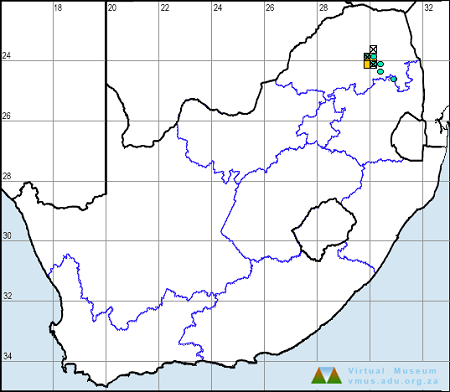Cover photo by Desire Darling.
Find the Elegant Malachite in the FBIS database (Freshwater Biodiversity Information System) here.
Family Synlestidae
Identification

Limpopo, South Africa
Photo by Gerhardt Diedericks
Large size
Length up to 63mm; Wingspan attains 76mm.
In South Africa, due to its habitat and restricted distribution, the Elegant Malachite should only be confused with Chlorolestes tessellatus (Forest Malachite) and Chlorolestes fasciatus (Mountain Malachite). The Elegant Malachite is the larger of the three species, with very little size overlap. Chlorolestes elegans has a yellow lower thorax stripe that curves noticeably upwards towards the wing bases (diagnostic). Chlorolestes tessellatus shows a less obviously curved stripe that grades to brown nearer the wing bases. Both species have forms with banded and unbanded wings. The best method for identification remains the males unique clasper morphology.
Click here for more details on identification.
Habitat
The Elegant Malachite is found in Malawi, Mozambique, South Africa, and Zimbabwe, where its natural habitats are rivers and streams in tropical and subtropical moist montane forests. It favours clear, rocky streams in densely vegetated, shady areas with pools and running water. The Elegant Malachite is only recorded above 1200m above sea level in South Africa.
Behaviour
The Elegant Malachite perches in dappled light with its wings outstretched, where it is well camouflaged.
It is on the wing from November to May (See Phenology below).
Status and Conservation
The Elegant Malachite is uncommon and highly localised. It is listed as Near Threatened in the IUCN Red List of Threatened Species. It is vulnerable to habitat loss.
Distribution
The Elegant Malachite ranges from the Limpopo province in South Africa, up along the Eastern Highlands of Zimbabwe and adjacent Mozambique to southern Malawi and Parts of northern Mozambique. It has a localised and disjunct distribution.
In South Africa, the Elegant Malachite is restricted to the northern escarpment forests between Wolkberg and the Soutpansberg in Limpopo.
Below is a map showing the distribution of records for Elegant Malachite in the OdonataMAP database as at February 2020.

Below is a map showing the distribution of records for Elegant Malachite in the OdonataMAP database as of December 2024.

The next map below is an imputed map, produced by an interpolation algorithm, which attempts to generate a full distribution map from the partial information in the map above. This map will be improved by the submission of records to the OdonataMAP section of the Virtual Museum.


Ultimately, we will produce a series of maps for all the odonata species in the region. The current algorithm is a new algorithm. The objective is mainly to produce “smoothed” maps that could go into a field guide for odonata. This basic version of the algorithm (as mapped above) does not make use of “explanatory variables” (e.g. altitude, terrain roughness, presence of freshwater — we will be producing maps that take these variables into account soon). Currently, it only makes use of the OdonataMAP records for the species being mapped, as well as all the other records of all other species. The basic maps are “optimistic” and will generally show ranges to be larger than what they probably are.
These maps use the data in the OdonataMAP section of the Virtual Museum, and also the database assembled by the previous JRS funded project, which was led by Professor Michael Samways and Dr KD Dijkstra.
Phenology
The next two graphs shows how the occurrence of Elegant Malachites varies within the year, i.e. the phenology. There are only 17 records in the database for this species, so these results need to be treated with caution. The first plot shows the number of records in each pentade, five-day periods, which start on 1 July and end on 30 June the following year. The maximum number of records in a pentade is three, in a pentade in May. The blue line is generated by a smoother, an algorithm which aims to separate the “signal” from the “noise”, and shows the pattern of seasonality for this species. The second plot shows only the blue line, and it is scaled to lie between zero and one, for easy comparison between species.


Tentatively (because the sample size is only 17), this phenology plot shows that the flight period of the Elegant Malachite is from November to May. The bimodality (i.e. having two peaks) is almost certainly an artefact caused by the tiny size of the sample. Lots more records of Elegant Malachites are needed in OdonataMAP to improve the phenology plot.
Further Resources
The use of photographs by Desire Darling and Gerhard Diedericks is acknowledged.
Elegant Malachite Chlorolestes elegans Pinhey, 1950
Other common names: Elegante Malagiet (Afrikaans).
Recommended citation format: Loftie-Eaton M; Navarro R; Tippett RM; Underhill L. 2025. Elegant Malachite Chlorolestes elegans. Biodiversity and Development Institute. Available online at https://thebdi.org/2020/02/27/elegant-malachite-chlorolestes-elegans/
References: Tarboton, M; Tarboton, W. (2019). A Guide to the Dragonflies & Damselflies of South Africa. Struik Nature.
Samways, MJ. (2008). Dragonflies and Damselflies of South Africa. Pensoft
Samways, MJ. (2016). Manual of Freshwater Assessment for South Africa: Dragonfly Biotic Index.Suricata 2. South African National Biodiversity Institute, Pretoria

